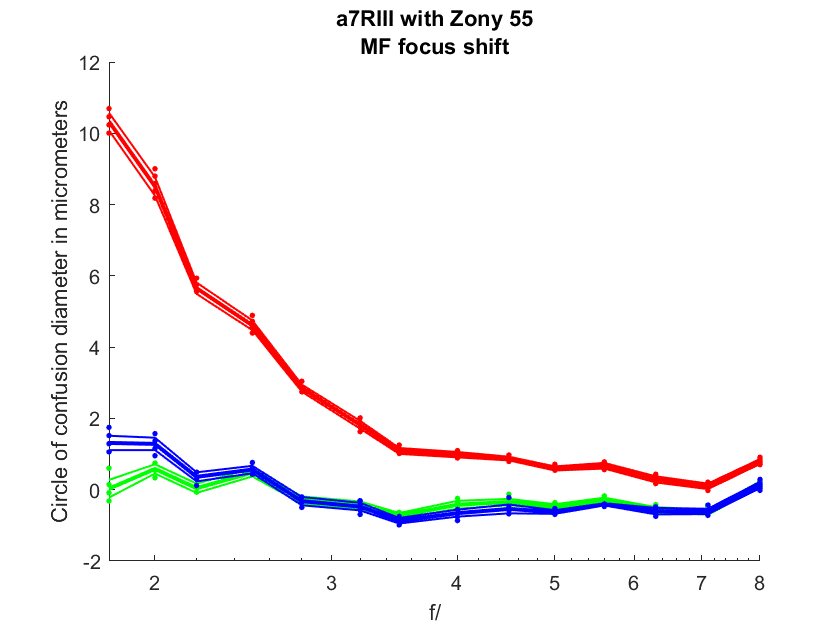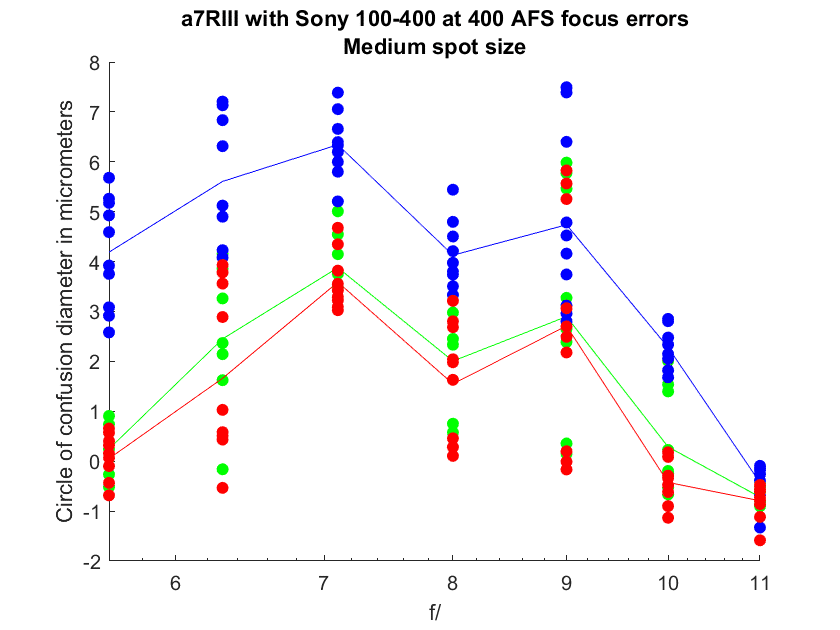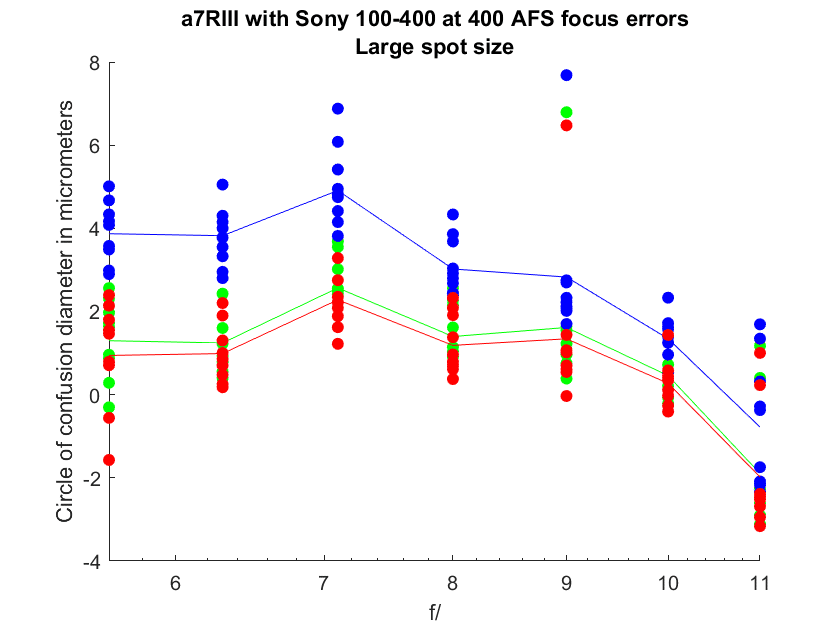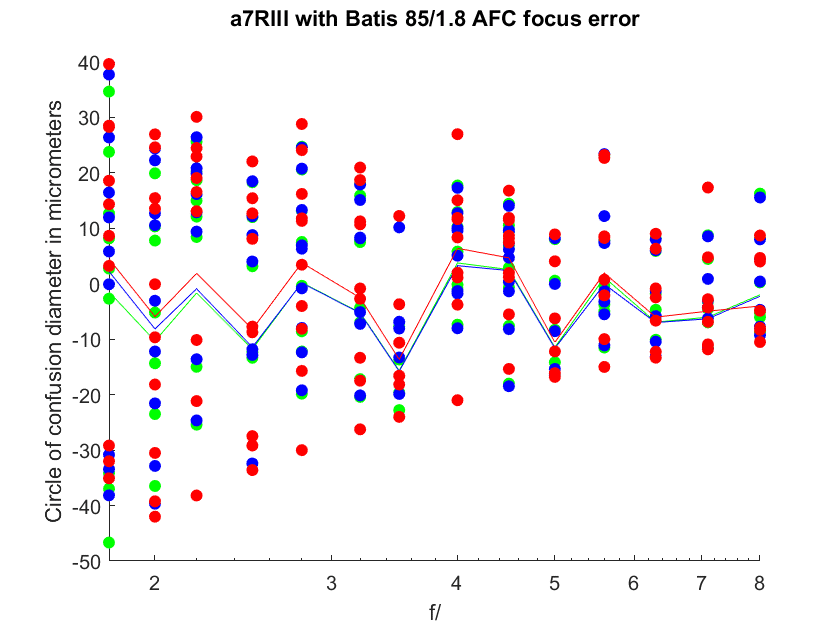This is a continuation of a series of posts on the Sony a7RIII. You should be able to find all the posts about that camera in the Category List on the right sidebar, below the Articles widget. There’s a drop-down menu there that you can use to get to all the posts in this series; just look for “a7RIII”.
Yesterday I summarized my findings over the last two months relating to the autofocus accuracy of the D850. Now I’ll do the same for the a7RIII. In a future post, I’ll compare and contrast (shades of high school!) the two cameras’ autofocus prowess.
The D850 does phase-detection autofocus (PDAF) in the finder and contrast-detection autofocus (CDAF) using the sensor. The user gets to control which system is employed. The a7RIII is more flexible by design, and more opaque in its implementation. It, too, has both CDAF and PDAF, but both systems are sensor-based, since there is no finder, ground glass, nor flipping mirror. Sony doesn’t talk much about how the two systems are arrayed in battle against defocus blur, but the camera appears to employ both depending on the settings, the lens attached, and even, in the case of the a7RII, the firmware revision number. I’m not going to enter the thicket of firmware revisions, but just describe how the a7RIII with firmware 1.00 works.
The combination of Sony’s reticence in discussing how their cameras autofocus, the existence of two modes, and the change in behavior with different lenses have sent their customers into paroxysms of arcane reverse engineering to figure out just what the heck is going on, and wrong answers abound. I myself, before I developed the tools that I’ve been using for the past month, was guilty of spreading what have turned out to be falsehoods, and I am happy to be able to undo the major one here.
In testing the a7RIII with the following lenses:
- Sony/Zeiss 55 mm f/1.8 (Zony 55)
- Sony 100-400 mm
- Sony 90 mm f/2.8 macro
- Zeiss Batis 85 mm f/1.8
- Sony 70-200 mm f/4
In AF-S mode, the a7RIII focuses with the lens diaphragm wide open, or very close to that. That means that the images are prone to suffer from focus shift. Some of the above lenses have remarkably little focus shift, so the way the a7RIII works is not always problematical, but others have significant focus shift.
Here’s a summary of the worst-case focus shift effects in size of the circles of confusion that result in micrometers:
- Sony/Zeiss 55 mm f/1.8 (Zony 55) — 2 um (but that gets worse using AF-S)
- Sony 100-400 mm at 400 mm — 4 um
- Sony 100-400 mm at 100 mm — 2 um
- Sony 90 mm f/2.8 macro — 5 um
- Zeiss Batis 85 mm f/1.8 — 10 um
- Sony 70-200 mm f/4 at 100 mm — 4 um (but AF-S makes that even worse)
I should note that there is far less focus shift for these lenses than many of the Nikon ones that I tested on the D850.
I don’t know of a workaround for this AF-S behavior other than using AF-C, which works because, in AF-C mode, the a7RIII focuses with the lens diaphragm at taking aperture, and focus shift is not a problem. It is ironic to me that the D850, supposedly the exemplar of obsolete tech in modern clothes, offers the user total control over which mode is used, and the wave-of-the-future a7RIII does not.
Some people have said that there are lenses that I haven’t tested that focus at taking aperture in AF-S mode. That is entirely possible, but there are lenses listed above that people said focus that way, so I’m from Missouri on this one, at least for now.
So what’s wrong with setting the camera to AF-C almost all the time? AF-C gives more focus variation than AF-S.
Using face detection can reduce focus plane variability.
Large spot sizes tend to create less variability in the focus plane than small or medium ones. That’s probably why face detection also helps, but that doesn’t explain the next one.
Using eye detection can reduce focus plane variability.
There is conventional wisdom that stopping down in AF-C increases variability. That is not always the case. This is about the worst AF-C variability I’ve seen at wide f-stops:




N/A says
> Sony/Zeiss 55 mm f/1.8 (Zony 55) — 2 um (but that gets worse using AF-S)
you mean AF-C
JimK says
No, AF-S. It’s um for manual focus.
N/A says
Jim, did you test for any possible differences between “Setting Effect” ON vs OFF for A7R3 – I think I missed that …
PS: Face Detection for example has issues with WB = UniWB with effects on under a daylight illumination, but works under a tungsten/halogen … means Sony works off converted OOC JPG to detect faces and looks for skin tones
JimK says
No, I always left setting effect ON, to allow the camera to stop down for focusing if it wished to.
JimK says
Good to know. I saw no difference with the camera set to AWB and illuminant color temperatures between 3000K and 6000K, and maybe you’ve just explained why.
Joel says
I’ve been following this series of posts but I may have missed something. Is there any change in the A7R3 if the emphasis is changed from “balanced” to “release” or “accuracy”?
JimK says
All tests done with both cameras at their most picky settings. I’m sure things get worse if you change those settings.
Frank Dexter says
What’s the difference between A9 / A7R iii AF. What about the 425 PDAFs. How do this hybrid AF work?
Is the A7R more accurate? Use the A7R both PDAF and CDAF to focus? Is it only in low light faster or more accurate than the A9?
Use the A9 only PDAF when high speed shooting? And only CDAF in low light?
Do you know a free source answering some of the questions?
JimK says
About all I can help you with is the a7R PDAF. It doesn’t exist. That didn’t happen until the Mk II version.
Also, with all the a7x cameras that have both PDAF and CDAf, and with the a9, there is, as far as I can figure out, no user-controllable way to force the camera to use only one focusing mode. There are some indirect ways that I’m not sure are 100% foolproof.
Frank Dexter says
Hey Jim.
Many thanks for the reply. I know the first gen 7R was 25 CDAF only. The second gen was 25 CDAF + 399 PDAF. The third gen now is much improved 425 CDAF + same 399 PDAF on the A7R iii. While the A9 has 25 CDAF + 693 PDAF.
It looks like the 7R iii and the A9 use a very different AF strategy. Are there no sources about that stuff?
JimK says
I don’t know of any authoritative sources, sad to say.
Pieter Gellings says
Hi Jim,
Do you know if there has been a change in AF implementation of the A7Riii versus older A7 cameras? Contrary to what you describe my A7 and A7ii focusses stopped down in both AF-S and AF-C (with setting effects ON and the FE55/1.8 CZ attached). So with those cameras there would be less problems with focus shift in both AF modes.
Regards,
Pieter
JimK says
There have been AF changes from release to release, let alone model to model. It’s quite confusing.
Christopher Ian says
Is anyone shooting studio based portraits with the SONY A7riii camera/ 24-70 GM lens? Having done 8000 + cycles using available light I’m trying to incorporate this combination with an Elinchrome lit studio.
EYE FOCUS is far too hit and miss with the back eye scoring a % of the time, and I don’t have the time during the shoot to check each shot for successful sharpness.
Will AF-S or A or C best cope with focus shift at F8 and what focus area setting returns the best results for front eye sharpness.
Frank says
Perhaps someone can help me figure out what is going on here and what might be causing it. I’m fairly new to Sony (A7R3, 55/1.8, batis 85/1.8). I have serious visual defects and am reliant on AF but had to resort toMF with magnification because all Af modes and all Af areas are proving to be unreliable in that I press the focus button (back button &/or shutter) and I see it grab focus, but then when I release my finger pressure it moves out.it doesn’t hold focus. I have tried Af-c, Af-s. Granted it is fairly low light but not nght or dark. Admittedl I hadn’t noticed it outside but did immediately in a studio setting with a strobe with a modelling lamp. Or even at home if I point ata table top lamp shade with texture and edges. The subject in studio also has contrast or texture. Menu settings, I have set focus to be the priority before release. I have the Af Illuminator on auto. Thanks for any indications
spankwire says
Sony did quite a lot with the A7R III despite keeping the same sensor from the previous camera and maintaining the form factor of the A7R II. In fact, many of the features of the Mark III are the same as with the second generation camera, but the things that Sony did change make a huge difference in the overall experience of the camera. It’s faster, more responsive and offers more features than its predecessor while fixing the biggest complaints users griped about with the Mark II.
Roger says
I think you said somewhere that the autofocus tests were done with firmware version 1.0. I know its an old post, but do you happen to know whether firmware upgrades since then have improved the focus shift performance? As they upgraded the eye-AF, maybe they did other tweaks for the AF.
Paul Chambre says
I checked on an A7R2 and an A7R with a variety of lenses. On the A7R, focus in AF-S was at taking aperture with all lenses. On the A7R2, AF-S would open to full aperture, except on the SEL2470Z. The SEL2470Z (FW 3.0) stayed at taking apeture on both cameras, regardless of lighting or ISO.
Lenses I had to try are:
SEL2470Z
SEL1855 (APS-C)
SEL55200 (APS-C)
Samyang 35/2.8
Sigma 30/2.8 (APS-C)
MC-11 + Sigma 150-600C, 100-400C, and 70-200S.
There has always been this theory, though, that AF-S would fine-tune with CDAF, to correct for focus shift, after stopping back down. Did you find any evidence for or against this?
I did try shooting mid-distance thin subject (back yard fence) with the 70-200 at 200mm, F2.8 and F8, to see if I could detect focus shift here, but, if there was any, it was swamped by the increased sharpeness and DOF from stopping down to F8.
JimK says
It’s been a long time, but I do remember getting results indicating that the lens was stopping down while focusing sometimes. I don’t know if it was using CDAF or not. Nikon is much more transparent about how the focusing systems works on the Zx.